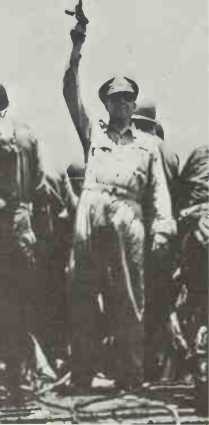Opposite top: The first wa e of marines hits the Saipan beach. Opposite bottom: Marines take cover after their landing on Guam.
General Douglas MacArthur led his forces through a series of amphibious landings along the northern New Guinea coast in preparation for his conquest of the Philippines.

Before MacArthur could begin his drive to liberate the Philippines, he still had to do some cleaning up in the Southwest Pacific. In April 1944 Allied forces took Hollandia in Dutch New Guinea. In May they pressed on to Biak and Wakde. Wakde was taken two days after the first Allied landings (ig May) but Biak proved more difficult. Allied forces were landed on the island on 27 May but it was not secured until the end of August, although an Allied air base had been constructed a month before the battle was over.
The battle for Biak would have been more difficult still if the Japanese had not decided to cancel a planned assault on Allied forces in the area in favor of sending what remained of the Japanese fleet against them in the Philippine Sea where landings on Saipan and Guam were imminent. The Saipan landing had actually begun while Biak was still being contested, on 16 June. When Allied leaders learned that Japan intended to engage Admiral Spruance’s task force, the Guam landing was postponed and the US Navy prepared to meet the Japanese in one of the last major contests in the naval war in the Pacific.
The Battle of the Philippine Sea began on ig June 1944. Unlike previous naval engagements in the Pacific, the American task force outnumbered its Japanese rival by more than two to one ships. More important, the American group that engaged the Japanese in the Philippine Sea was well seasoned. Whereas the Japanese had sustained heavy losses in personnel and equipment, particularly aircraft, by the summer of 1944, which forced them to rely on improperly trained seamen and fliers, the United States taskforce was experienced and able. The battle, therefore, proved to be an uneven match. By the time the Japanese retreated on 21 June, they had lost at least three carriers and more than 300 aircraft, a loss that the Imperial Japanese Navy could ill afford to sustain.
After the defeat of the Japanese fleet the capture of Saipan was only a matter of time. Had it not been for the fierce resistance of the Japanese garrison on the island, the Marines would have wrapped things up in a few days but as it happened, the campaign took several weeks. The Japanese did not surrender until 8 July and even then pockets of resistance still had to be cleaned out. Perhaps the term ‘surrender’ is misleading since the commander of the Japanese force on Saipan, General Yoshio Saito, ordered his men to fight to the death and fought to his own death beside them. Given this suicidal resistance and the difficult terrain of the island, the Marines sustained unusually heavy losses before the island was secured with 3400 dead and over 14,000 wounded. Japanese casualties have been estimated at more than 24,000, one of their worst disasters of the war. Tojo was forced to resign as Premier shortly after this dreadful toll was announced in Tokyo.
The neutralization and conquest of Saipan had hardly been completed when the Allies attacked Guam and Tinian. Following a massive bombardment ofjapanese installations, Guam was invaded on 21 July, and Tinian on 24 July. Both campaigns were efficiently and rapidly completed; the Stars and Stripes flew over Tinian by 3 August, and Guam was subdued by the loth. Army engineers and Seabees lost no time in constructing and expanding air bases on the two islands, giving the Allies bases within easy flying time from Formosa and the islands from which to launch their B-2g strikes. For Japan, the end was near.




 World History
World History









